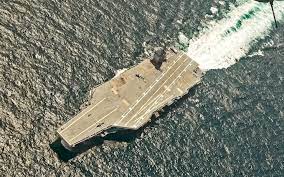Lewis Page
So, Chinese wargamers have claimed that China’s latest long-ranging hypersonic ballistic missiles can destroy a US aircraft carrier group from thousands of miles away. Top-secret US intelligence reports revealed in the Discord leaks also state that the latest DongFeng-27 (DF-27) hypersonic glide missile was successfully tested in February, and that it can threaten targets well out into the Pacific.
Well, that’s it, surely? Aircraft carriers are obsolete. Taiwan can’t expect any help when the Chinese invasion comes. America will shortly be compelled to abandon its democratic allies up and down the China coast from Japan to Australia. There may be a few things to think about, however, before scrapping the US Navy surface fleet and beginning the pullout from the First and Second Island Chains.
First is that the “ballistic missiles can destroy US aircraft carriers from afar” is actually an idea that has been kicking around for decades. The Western media with its short attention span is perennially amazed by it, but it’s a very old story. It gets a lot of traction in military circles, because about two-thirds of the Western military, the people from the armies and the air forces, dislike aircraft carriers and wish they didn’t exist. In fact the first anti-ship ballistic missile (ASBM) was developed almost 50 years ago. The Soviets deployed the R-27K in 1975. This could be fired from a submarine at targets a few hundred miles away. It had a manoeuvring re-entry vehicle with a radar tracker that could locate a ship within an area of sea 50km across, and steer itself so as to strike within a few hundred yards of it. Even US aircraft carriers aren’t big enough that you can hit them reliably with this sort of accuracy, but the R-27K had a one-megaton nuclear warhead. Close would have been good enough. So why did the USA keep on building aircraft carriers, launching no less than 11 of the huge, expensive monsters since then?
The first part of the answer is that it is no simple matter to pin down where a US carrier is to within 50km. You can send out long-ranging reconnaissance planes to look for it, but a US carrier group expecting trouble keeps a Hawkeye radar-surveillance plane airborne around the clock. Thanks to the inescapable curvature of the Earth, the Hawkeye – being high up in the sky – will detect a reconnaissance plane long before the recce plane can find the carrier. Shortly thereafter, the carrier’s fighter jets will make sure the intruder gets no closer. The old-time Soviets came up with various schemes to solve the problem of locating US carrier groups. One plan called for simply overwhelming the carrier’s defences with waves of heavy bombers, though even the Soviets would probably have struggled to find enough aircraft for this. The Soviets also sought to use satellites to find their enemy. The problem here is that most kinds of satellite offer only a so-called “drinking straw” view of the Earth beneath. If the satellite’s operators know where to look the spacecraft can produce a very detailed picture, easily good enough to identify an aircraft carrier, but knowing where to look is the whole problem.
One potential solution is to build a satellite with radar, which from space could potentially sweep huge areas of ocean. The trouble here is that a long-ranging radar at orbital altitude needs a lot of energy, and satellites don’t normally have much available because the solar panels which power them don’t produce much. This led the Soviets to build radar satellites which were nuclear powered: not just with relatively humdrum radioisotope generators, but actual small nuclear reactors. Between 1967 and 1988 the Soviets put 33 nuclear powered radar-ocean-reconnaissance satellites (Rorsats) into space. Most of the reactor cores are still up there: they were parked in high “storage” orbits before the main spacecraft descended at the end of their lives. This didn’t always work: two reactors ended up in the sea and another one scattered itself all over some remote parts of Canada. One of the “stored” satellites appeared to suffer some kind of accident and broke up into a cloud of debris in 2014. Despite the Rorsat programme, the USA never decided that aircraft carriers were obsolete, and kept on building them. One reason for this confidence would probably be that there are an awful lot of ships in the sea, and while radar may locate them all it won’t tell you which blip is the US carrier you’re looking for. Another may have been that the Rorsats reportedly had serious reliability issues apart from their buggy reactor-disposal systems, and were often offline. In any case, the programme ended with the fall of the Soviet empire.
Today we’re talking about China, which has had a dislike of US aircraft carriers since the Taiwan crisis of 1995-1996. During this affair, Beijing attempted to use its military muscle to influence Taiwanese internal politics, specifically the 1996 election – one of the earliest proper ones held there, as Taiwan transitioned to democratic government. China fired missiles and rattled its sabre, but failed to frighten the Taiwanese into voting for the pro-Beijing candidate due to a massive display of US naval power, including two carrier battle groups which were able to cruise in and out of the Taiwan Strait with impunity. China immediately began its long naval buildup, which is continuing at pace today, and began its quest for a missile like the Russians’ old R-27K. This involved no particularly new technology. Weapons were shown off in parades as early as 1999 which could do what the R-27K could, and probably had more accurate seeker heads able to make a direct hit on a ship and damage or sink it without resorting to a nuclear warhead. Early tests of such Chinese systems reportedly happened in the mid-noughties, and the “news” that aircraft carriers had been rendered obsolete started to come round regularly from then on. In 2010 it was announced that the D anti-ship version of the venerable DF-21 ballistic missile was operational, and in 2013 internet satellite-picture aficionados were amused to find that there was a mockup US aircraft carrier sitting in the middle of the Gobi Desert: a target for DF-21D tests.
There can’t be any doubt that China now has missiles which can range thousands of miles and hit moving targets such as ships – if China knows roughly where the target ship is, and if nothing gets in the way. China is certainly working on finding the carriers. It has launched various satellites which may help, including radar ones, but they are up against the same inverse-power physical laws of radar return as the Soviet Rorsats were, and none of the Chinese spacecraft so far are nuclear powered so they probably aren’t as capable. China is also attempting to make groundbased radar which can reach beyond the horizon: this too is a very old idea and many such projects have been carried out by many nations ever since radar was invented. Sometimes it is admitted during testing that the system doesn’t work, as with the US/UK “Cobra Mist” of the 1960s: sometimes the system supposedly goes “operational” only to be quietly scrapped later. Meanwhile people keep on building and using airborne radar aircraft, which actually work. Perhaps the Chinese have finally cracked over-the-horizon radar at last, but it doesn’t seem likely.
China is also trying new things which might solve the find-the-carrier problem. Drone watchers were intrigued last month to see recent satellite photos showing China’s WZ-8 hypersonic drone parked at an airbase in eastern China. The WZ-8, first unveiled in a military parade in 2019, is rocket powered. It’s dropped from a heavy bomber to streak across an area of interest at up to Mach 7, high up. It reportedly carries both radar and optical sensors, and so it might be able to finger a carrier for targeting by missiles: though most analysts think it will be more useful for probing fixed bases. As we shall see, a carrier group would probably be able to destroy a WZ-8 before it had seen much. All in all then, it’s fair to say that China’s find-the-carrier abilities are unlikely to be really much better than the Soviets’ were – if as good. It would be easy, of course, to construct a wargame that said different, as the “researchers” making the news this week did. And maybe the WZ-8 or some other special sauce really has, finally, solved the problem that the world’s bad guys have been working on ever since the 1950s. If that’s true, are aircraft carriers obsolete, as so many people want to believe?
There’s another factor to consider. It’s surely true that US Navy carrier fighters would be unable to stop ballistic DF-21D warheads plummeting down from the edge of space. But every US aircraft carrier is accompanied by cruisers and destroyers carrying the powerful Aegis weapons system, which fires a range of different Standard Missiles (SMs). Aegis and Standard have had anti-ballistic-missile capabilities for a long time. The SM-3 can actually knock down targets travelling in space above the atmosphere, which doesn’t bode well for the ability of low-orbiting Chinese spy satellites to survive a pass over a US carrier group during a shooting war. Later versions of the SM-2, and the new SM-6, can knock down ballistic missile warheads in their terminal phase as they plunge down through the atmosphere. It has turned out in Ukraine that land-based US Patriot interceptors are an effective defence against Russia’s vaunted “Kinzhal” missile, which strikes at Mach 10. The Standard is thought to be at least as good, so it seems likely that it can pick off WZ-8 probe drones and incoming DF-21Ds.
The suggestion is that the new Chinese DF-27, with hypersonic glide warheads which can swerve about as they come, will be more difficult to defend against. But throughout the aircraft-carriers-are-obsolete saga it has been clear that China’s capability is always portrayed as being more advanced than it actually is: and US interceptor tech usually turns out to be able to do things people thought it couldn’t, as in Kyiv last week. The DF-27, in fact, is probably still in test and development. The Chinese wargamers probably made some optimistic assumptions about it, and about China’s ability to actually locate US warships. It wouldn’t be a surprise in the real world to find that the SM-6 can actually deal with at least some kinds of hypersonics in their terminal phase. And by the time the DF-27 is in service, and China has finally learned to find aircraft carriers, the current US Glide Phase Interceptor and Hypersonic and Ballistic Tracking Space Sensor projects will have delivered the new generation of counter-hypersonic weaponry. The new interceptor is being specifically designed to be fired by Aegis warships, too. So aircraft carriers will still not be obsolete. Indeed, it seems pretty certain that Xi Jinping doesn’t personally believe that his own missiles have rendered aircraft carriers useless. We know that for sure, because he is building his own aircraft carriers as fast as he can.
The Telegraph







